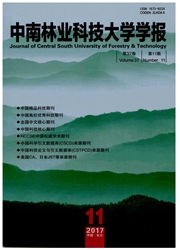

 中文摘要:
中文摘要:
以李家洲林场为研究区域,选择典型样地为评价单元,选取与林地环境密切相关的8个因子构建指标体系,运用主成分分析法及聚类分析法对长江外滩7个样地抑螺效果进行了定量研究。采用主成分分析将8个指标提取出3个主成分,应用分层聚类分析法对该3个主成分的因子得分进行聚类,在此基础上,将主成分得分与其对应的特征值相乘,得到环境抑螺效果评价指数,最后将样地划分为4类,取其平均值对每一类确定抑螺效果等级。结果表明:农林、农药间种的抑螺防病林抑螺效果相对较好,且间种时间越长抑螺效果越好。3年生杨树纯林与油茶间种的复合林抑螺效果最为明显,而1年生的杨树纯林同1年生杨树与小麦的林农复合林二者环境抑螺效果最低。
 英文摘要:
英文摘要:
Through taking the forest farm of Lijiazhou as a case and choosing field plot scale as the assessment unit,and selecting the 8 factors closely related to forest land environment to construct evaluation indicator system,the snail controlling effects of 7 plots on the beaches of the Yangtze River were quantitatively studied by means of principal component analysis(PCA) and clustering analysis.Three principal components were extracted from the 8 factors by using PCA,the cluster analysis of factor scores of the three principal components was made by employing hierarchical cluster method.On the basis of the clusterings,the index of effect evaluation of the environment to control Oncomelania was obtained by means of multiplying each of the principal component score with its corresponding eigenvalue,and the plots were divided into 4 types and the Oncomelania control effect of every plot type was determined by the average value of the index.The results show that 3-year-old complex forest of poplar and Camellia had the most significant effect of snail prevention,while 1-year-old pure poplars,1-year-old complex forest of poplars and wheat had the lowest presented effects.
 同期刊论文项目
同期刊论文项目
 同项目期刊论文
同项目期刊论文
 期刊信息
期刊信息
